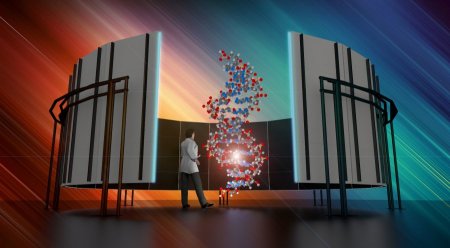A scene in Star Wars. Life-like avatars. Cave Automatic Virtual Environment. They all germinated in UIC’s Electronic Visualization Lab. A place where the clock is always 15 years fast.
This article, by Stuart Luman, appeared in “UIC Alumni Magazine,” Winter 2011. Below are excerpts.
Since its founding in 1973 as the Circle Graphics Habitat by artist and physicist Daniel Sandin and computer scientist Tom DeFanti, EVL has been a bridge between technology and the arts. A joint program of UIC’s College of Engineering and the School of Art and Design, it was one of the nation’s first such labs. EVL students can graduate with an MFA in electronic visualization (perhaps, the oldest degree of its kind in the country) or an MS or PhD in computer science.
Although not as well known or well funded as institutions such as MIT’s Media Lab, EVL has a long history of radically changing the way people visualize and interact with data and technology.
Jason Leigh, PhD ’98 Eng, the lab’s director, was recently profiled on PBS’s Nova ScienceNOW and the Discovery Channel’s Popular Science’s Future Of. What caught the producers’ attention was Leigh and his colleagues’ efforts to create life-like computer avatars. The project, fittingly called LifeLike, seeks to digitally capture a person’s likeness, facial expressions and speech patterns and to create virtual reproductions that can interact with people far into the future. It’s all part of an effort by Leigh – and those at EVL – to push the boundaries of technology. “It’s one step closer to living in my Star Trek future,” says the 46-year-old Leigh, who has spent the last 20 years at EVL, first as a graduate student and then a professor, before becoming its director in 2005. “When I was a kid, I wanted to live in the science fiction world that Captain Kirk was living in. All we’re trying to do is to make it real.”
The lab remains focused on research that might not pay off for at least 15 years and that corporations can’t or won’t indulge in. One example is advanced networking, which EVL can undertake because it benefits from an incredibly fast fiber-optic network that can process data at 30-gigabits-per-second, roughly 30,000 times faster than even the fastest home broadband. At the same time, the lab is building larger and larger flat-panel, tiled displays, which users can touch, interact with and link to via SAGE. This will allow groups to enjoy greater collaboration and to work together anywhere on the planet, eliminating distance barriers.
To read the complete article, go to: www.uiaa.org/uic/news/uicalumni/1111a.html
